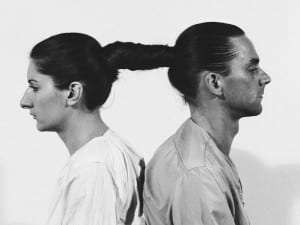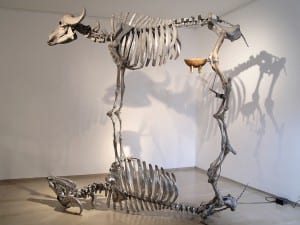Challenging the boundaries of art and fashion, Alex Box’s inaugural exhibition fuses figures from the artist’s imagination onto the face, in an eclectic display of the transgressions of make-up
Primordially our bodies are tools for expression, the most immediate way through which we can express ourselves without even knowing. In fashion – the work of the stylist, the designer, the hairdresser and the make-up artist invert this compulsion, hijacking the bodies of others to express together their collective vision. Alex Box, in collaboration with Rankin, takes on a mission of self-expression through the faces and bodies of her models, transforming them as a canvas while retaining their distinctive features in an exploration of the boundaries between art, make-up and fashion.
Box is renowned in fashion for an eccentric approach to the face as a canvas, belying her art school roots with flamboyant, mysterious creations for the likes of Garth Pugh, Karl Largerfeld, Alexander McQueen and Stella McCartney, as well as having fashioned faces on shoots for I-D, Vogue, Numero and Dazed and Confused. The parade of fantastical portraits is a thoroughly fashionable affair, the inaugural show at Rankin’s new gallery space in Kentish Town, the Annroy Gallery, as two of the industry’s biggest creators present their commercial skills as fine art.
As a Chelsea School of Art alumni, Box has a history of mingling the mediums, starting as a painter, and quickly moving into photography, sculpture and installation. In her formative years, Box was enjoying tutorials from the high profile YBAs: “People like Dinos Chapman would come in as tutors, which was fantastic as they were so current at the time.” After the excitement of Freeze (1988), the art scene to which Box was introduced focused intently on installation, with work influenced by Matthew Barney, Jake and Dinos Chapman, and Michael Craig-Martin, and Box’s movement towards make-up became a natural consequence of this focus: “I started using myself in a lot of images and manipulating bodies,” and a fascination with the projections of fashion cemented her interest: “I was very interested in the way they created these perfect, icons of desire. My work was about desire, texture, surface, shape and a distillation of the idea of the perfect thing. So I was breaking those images down and make up was very important in that.”
The exhibition and publication are a curious amalgamation of Box’s specialities, highlighting her interest in and crossover of numerous art forms. For Box the movement around mediums is organic: “A friend liked the way I did paintings and there’s not much difference between painting and make-up so it all started gelling together. I started doing make-up as part of my artwork, somebody asked if I wanted to do a fashion shoot, they all started to blur together.” As a regular on the fashion show circuit, and creative director of Illamsaqua, Box’s work is firmly entrenched in a commercial framework, but the exhibition and book release mark a return to her roots, and an opportunity for more transgressive work between the two elements of her career. “What’s so exciting about the book is that I’ve come full circle because I’ve started drawing again. We shot models with no make up on, blew up the pictures, drew on them and reprinted them. My make up has become my artwork again whereas before it was my artwork was my make up.”
Gelling the commercial and the exotic, Box recognises the boundaries between art and make-up and how one has enhanced the other. “I really relish a brief, making an image with a team of people, you get pushed into areas that you wouldn’t normally go yourself and it broadens your scope and hones your talent. I’ve found the parameters of fashion helped me as an artist, they’ve made me more efficient, not as indulgent, and I produce more.” In enhancing her work, Box enters the contentious battlefield between fashion and art. “Art is emulating fashion a lot of the time, that perfect desire, epitome of inspirational images. Art derides the fact that fashion is so throwaway, whereas fashion people love that art gets so much time to hone a project and how it’s infallible, nobody questions it, it’s an interesting swing.”
Fashion and photography could be described as high art for the masses, and this is what the exhibition produces – beautiful images, of beautiful women, enhanced by a world-renowned photographer and make-up artist. The pages of a glossy magazine reach so many more people internationally, at such a faster rate, than the world’s greatest artworks. The latest “It Bag” enters our popular consciousness much more easily than the latest conceptual zeitgeist, and for those immersed in the industry, this is where the appeal lies; in mass exposure to the populace, through magazines, billboards, store-fronts and television. It’s no wonder fashion is seen as so accessible, we live in it every day, but with its almost obsessive preoccupation with beauty, the young, and the new. It never becomes humdrum enough to be everyday.
Box recognises that the how-to approach applied to much make-up work is “the antithesis to how art is. Art’s much more appreciated for the final thing and people don’t want to know how you got there. It’s more about the aesthetic and the content.” It’s this ivory towers aura around art that Box applies to her own work in make-up: “You should be inspired and enthralled by an image without breaking it into pieces.” The figures on display range from peaceful models almost mummified in neon spray, to porcelain clowns, segmented into two dimensions, and bare glimpses of skin glinting out of pitch black backgrounds. They elucidate ethereal, other-worldly qualities. Box is removing us from the everyday, building up the mystique to comply with the bewilderment aroused by contemporary art, because this is where the attention is retained, in contrast to the frenetic pace of fashion trends. “So many people want to do things for themselves so they can debunk the myth, because people feel that something has happened that they can’t explain, but that’s the whole mystery of art and that’s what’s fantastic because in that whole area of not knowing there’s magic and discovery. The problem is that once people feel that they’ve got a hold of knowing they’re not interested. The prolonging of desire is something that I’ve always been interested in and that’s very much a part of my make-up work – I can’t explain how I get there.”
Box’s images are beautiful: “I never want it to be destructive and ugly.” Of course this is helped by the notion that she is a make-up artist, starting from the canvas of exceptionally beautiful women, but if this is art, where’s the challenge? It has long been inherently unfashionable to associate art with beauty. Across the ages works by the likes of Francis Cadel and Jack Vettriano, have been critically condemned for being too accessible. Art is expected to challenge, to take us somewhere else and outside of our normal concepts and thoughts. Beauty is an important aesthetic to Box, and the images challenge our thoughts on art as the mysterious figures take on a life of their own. With the eyes exposed, there’s a sign of a spirit, which both gives us a familiar focal point, and unsettles us in this unique combination of face and artificiality.
“Beauty’s a strange word and I’ve been exploring it with the book. When the work tips into something that’s not beautiful, it feels abusive, like you’ve taken a spirit away, it’s against my aesthetic. It’s difficult to make something beautiful when it’s extremely subversive material that you’re using or it’s against the normal way of application – using strange colours, taking away the hair or eyebrows, all the things that are traditionally seen as areas of attraction. If you mess around with proportions there’s only so far you can go and you know when to stop. It’s quite interesting because in the later images, the face couldn’t be more covered, but there’s still a connection with the person that you’re looking at.” The energy of the face leads Box’s drawing: “You’re in such close proximity with a person that there’s an energy, it’s not like a canvas. You’re definitely guided by somebody’s spirit, a connection with the way their face is, their heat, and their character.” Models are chosen to carry the work in a regal manner, again enhancing its otherworldliness: “Even with the most extreme make-up for me, the person who’s wearing it doesn’t look ridiculous, they have a majesty over how it looks.”
The most refreshing images are Box’s own works of illustration, and her future plans involve more work building onto the face: “I wanted the book to be very much about illustration and painting so everything’s pigment based, everything’s line, either drawn by hand on the pictures or used with brush and pigment and paint on the model, but for my next project to just concentrate on face architecture and building away from the body.” From Maori tattoos, tribal masks, piercing, painting and plastic surgery, the face has been enhanced for generations in increasingly invasive ways, and Alex Box contextualises this within the inherently commercialised 21st Century culture.
Alex Box was published by Turnaround (£50) and the exhibition ran at the Annroy Gallery, Kentish Town from 23October – 22 November 2009.
Pauline Bache




